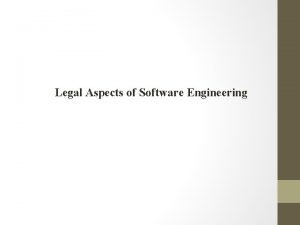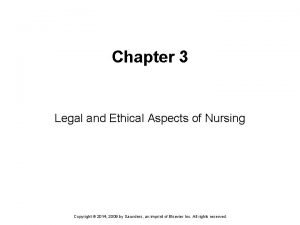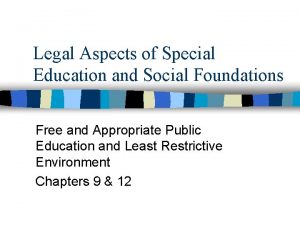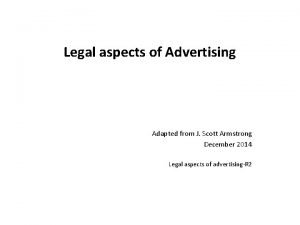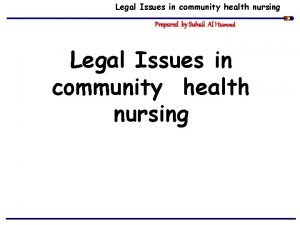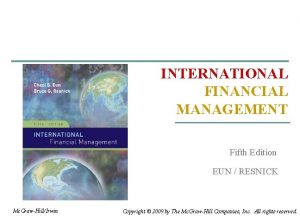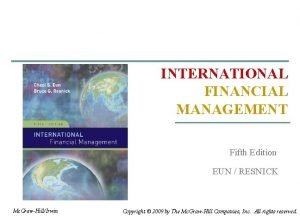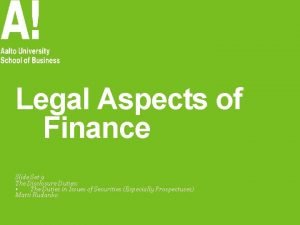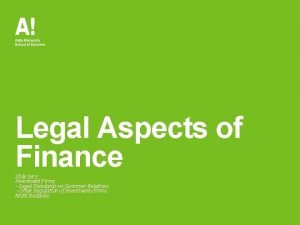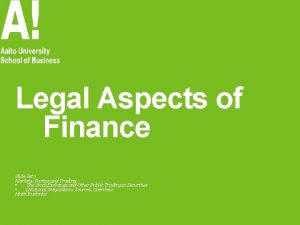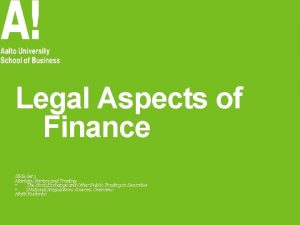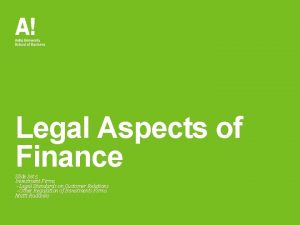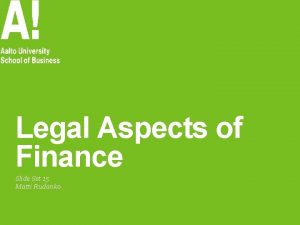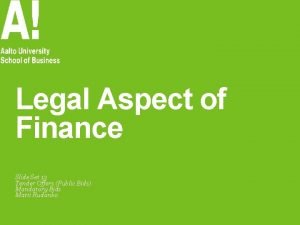Legal Aspects of Finance Slide Set 4 a





















- Slides: 21

Legal Aspects of Finance Slide Set 4 a 1. Payment Services Directive 2. What does the Directive mean to banking 3. Blockchain technology on Financial Markets

The PSD 2 disruption PSD 2 enables bank customers, both consumers and businesses, to use third-party providers to manage their finances. In the near future, you may be using Facebook or Google to pay your bills, making P 2 P transfers and analyse your spending, while still having your money safely placed in your current bank account. Banks, however, are obligated to provide these third-party providers access to their customers’ accounts through open APIs (application program interface). This will enable third-parties to build financial services on top of banks’ data and infrastructure. Legal Aspects of Finance 4 a 2

Changes on competitive markets for banking Banks will no longer only be competing against banks, but everyone offering financial services. PSD 2 will fundamentally change the payments value chain, what business models are profitable, and customer expectations. Through the directive, the European Commission aims to improve innovation, reinforce consumer protection and improve the security of internet payments and account access within the EU and EEA. Legal Aspects of Finance 4 a 3

New competition positions The required bank licenses and low consumer-trust towards third-parties make it difficult and troublesome for new entrants to enter the market. Non-bank Fin. Tech companies probably will play a significant role in the future financial landscape. However, with PSD 2 this might change, as it will be easier for non-banks to enter the market with financial service solutions. Legal Aspects of Finance 4 a 4

New actors on the market AISP (Account Information Service Provider) are the service providers with access to the account information of bank customers. Such services could analyze a user’s spending behavior or aggregate a user’s account information from several banks into one overview. PISP (Payment Initiation Service Provider) are the service providers initiating a payment on behalf of the user. P 2 P transfer and bill payment are PISP services we are likely to see when PSD 2 is implemented. Legal Aspects of Finance 4 a 5

Consumer preferences and trust Consumers are slowly getting used to using non-banks for financial tasks and it seems like this trend is only continuing. Paypal has already existed in close to 15 years and has gained great consumer trust. Swedish Tink and the Danish Billy are companies that have also gained a great market share without a banking license. Every fifth European consumer say they would use by financial products from challengers such as Google, Facebook and Amazon Legal Aspects of Finance 4 a 6

Competitive changes and consumer trust The competition within the financial sector will be dramatically increased, due to the introduction of PSD 2, technological innovations and changing customer demands. Customers will be enabled to create their own collection of smaller service providers instead of choosing one specific bank for all financial needs. As PSD 2 will increase the opportunities for companies without a banking license to enter the financial market, it is likely that the trend of increased consumer trust in nonbanks will continue to grow. Legal Aspects of Finance 4 a 7

Challenges to banks to find new business models IT costs are expected to increase due to new security requirements and the opening of APIs. In addition, 9 percent of retail payments revenues are predicted to be lost to PISP services by 2020. And, as non-banks take over the customer interaction, banks may find it increasingly difficult to differentiate themselves in the market for offering loans. This, in addition to changed customer expectation and increased digitalisation, may be why we today are witnessing more and more banks experimenting with their APIs, collaborating with fintechs (financial technology companies), focusing on customer centricity and setting up innovation labs. Legal Aspects of Finance 4 a 8

Requirements to banks to modify business One way that PSD 2 opens up for nonbanks is through open APIs. By using banks’ APIs non-banks can enter the financial market without the heavy compliance and infrastructure which banks are required to maintain. This opens up the financial market to new entrants with fresh ideas about how to shape the banking experience. Some banks have already started making their APIs available. Legal Aspects of Finance 4 a 9

Future trends of banking business Leaps in technological progress - particularly driven by the mobile platform - have led consumers to expect a seamless multichannel experience and a consistent, global service. As a result, one of the main challenges for banks has been to transform their existing service models to meet customer expectations, while keeping costs down. Open Banking transformation paves way for the adoption of open APIs, which in turn presents strategic opportunities where external service providers build on top of banks’ data and architecture. Open Banking help banks bring engaging services to market faster and cheaper than they would be able to themselves. Legal Aspects of Finance 4 a 10

Future trends of banking business Open Banking strategies offer many opportunities for banks, but it may be challenging for a bank to decide which opportunities to pursue. Should a bank embrace the role as a fintech app store, a member in someone else’s ecosystem, or find relevant partners to serve niche and local markets? Legal Aspects of Finance 4 a 11

Technology based business innovations New entrants no longer will offer the full banking experience package to enter the financial market due to the increased use of APIs. New entrants can now focus on offering just a single service and connect to other service providers through cloud solutions or APIs. Also, new improved services within payments are emerging, making banking both faster and easier. Contactless payments and mobile solutions are services that technology have recently led to. Legal Aspects of Finance 4 a 12

What is the blockchain? Until cryptocurrencies came along, no one had the ability to transmit value at a distance without the permission and support of a third party. A blockchain is a network of computers, where all the members of the network maintain a shared, trusted, public ledger that everyone can inspect, but that no single user controls. The ledger is built using a linked list, or chain, of blocks, where each block contains a number of transactions that was performed in a given timespan. The global distributed ledger facilitates the movement of assets across the world in seconds, with only a minimal transaction fee. These assets can be any type of value, as long as they can be represented digitally. Legal Aspects of Finance 4 a 13

The blockchain network P. 9: Each member of the network, called a node, holds a chain of blocks which constitutes a total history of transactions performed on the network. Each block holds a set of transactions, which size depends on how many transactions were completed Legal Aspects of Finance 4 a 14

Transaction stages P. 10 – 11: Transaction definition Block chaining Block validation Transaction authentication Block creation Legal Aspects of Finance 4 a 15

Permissioned Ledgers: Industry. Level Systems of Record PAGE 14 In a permissioned ledger, the validation process is controlled by a preselected set of nodes. It is a system run by a consortium of financial institutions, where a certain majority have to sign every block in order for it to be valid. The access rights to read the blockchain might be public or restricted to just a certain number of participants, such as government -approved auditors. Legal Aspects of Finance 4 a 16

Permissionless Ledgers: Censorship resistant P. 15: there is no gating or authorizing process to enroll into the transactions scheme (a public ledger). Everyone is free to download a copy of the blockchain ledger, and they are able to join as anonymous validators by performing computationally intensive proof-of-works. Public ledgers may be practical for primarily on chain assets, meaning assets that are endogenous and created on the ledger (e. g Bitcoin). Off-chain assets are not controllable by the validators in the same way as the native assets, and any conflicts in a transaction would need to be solved by an outside party or legal entity. Legal Aspects of Finance 4 a 17

Smart contracts A general definition of a smart contract would be a computer program that can automatically execute the terms of a contract. By being self-executing and having property ownership information embedded, they can solve the problems of counterparty trust. Banks are expected to start turning paper syndicated loans into smart contracts where the terms and conditions are programmed, then shared to the syndicate of lenders across the distributed ledger. P. 30 - 31 Legal Aspects of Finance 4 a 18

Transfer of payments In the payments space, the biggest challenges financial institutions face have to do with the silos within banks. Many of them have built various and complex IT Infrastructure. At a procedural level, the process of inter-bank clearing requires an intricate coordination of resource-intensive steps between banks, clearing houses, and the central bank. Recording all transactions in real-time on a blockchain ledger would mean more efficient execution of inter-bank payments. The central bank would need to launch a digital asset, preferably a cryptocurrency, which all parties agree upon as being representative of the same liability. P. 32 – 35 Legal Aspects of Finance 4 a 19

Capital markets Trading on the market: (p. 38 – 40) • Create a representation of an asset, such as a currency, bonds, stocks, gold, etc. • Enable a trade to take place between two or more stakeholders. • Balances must be recorded and kept. • The eventual liquidation of an investor’s position By adopting a shared distributed ledger platform, stakeholders could be eliminating the need for replication and duplication of the same data E. g. Nasdaq & Chain Legal Aspects of Finance 4 a 20

On a shared distributed ledger platform Asset creation: Any type of asset can be created on the network if the trading partners are in agreement. Trading: Assets can be traded on the network with a minimal transaction fee in atomic transactions (either fully executed, or not at all) Balance: Balances are recorded on an shared replicated ledger where each position are constantly netted. Settlement: The network can also host the currency assets that back the tradable assets Legal Aspects of Finance 4 a 21
 Heel toe dance
Heel toe dance Total set awareness set consideration set
Total set awareness set consideration set Training set validation set test set
Training set validation set test set Legal aspects of catering premises
Legal aspects of catering premises Mario full screen
Mario full screen Legal aspects of doing business in canada
Legal aspects of doing business in canada Legal and ethical aspects in nursing
Legal and ethical aspects in nursing Legal and ethical issues in computer security
Legal and ethical issues in computer security Legal aspects of special education
Legal aspects of special education Legal aspects of advertising
Legal aspects of advertising Apa yang dimaksud dengan manajemen pembangunan proyek
Apa yang dimaksud dengan manajemen pembangunan proyek Ethical and legal issues in community health nursing
Ethical and legal issues in community health nursing Scbon
Scbon Nursing legal terms
Nursing legal terms Legal aspects definition
Legal aspects definition Ethics and professional responsibility cpd
Ethics and professional responsibility cpd Expanded opportunity set
Expanded opportunity set Goals of international financial management
Goals of international financial management International financial management 5th edition
International financial management 5th edition How to slide and divide factoring
How to slide and divide factoring Bounded set vs centered set
Bounded set vs centered set Fuzzy logic
Fuzzy logic




